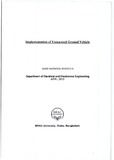| dc.contributor.advisor | Azad, AKM Abul Kalam | |
| dc.contributor.advisor | Sadi, Mehdi Hasan | |
| dc.contributor.author | Mahmood, Marif | |
| dc.date.accessioned | 2011-04-20T05:11:55Z | |
| dc.date.available | 2011-04-20T05:11:55Z | |
| dc.date.copyright | 2010 | |
| dc.date.issued | 2010-04 | |
| dc.identifier.other | ID 09221210 | |
| dc.identifier.uri | http://hdl.handle.net/10361/884 | |
| dc.description | This thesis report is submitted in partial fulfillment of the requirements for the degree of Bachelor of Science in Electrical and Electronic Engineering, 2010. | |
| dc.description | Cataloged from PDF version of thesis report. | |
| dc.description | Includes bibliographical references (page 30). | |
| dc.description.abstract | Unmanned ground vehicles (UGV) are robotic platforms that are used as an extension of human capability. This type of robot is generally capable of operating outdoors and over a wide variety of terrain, functioning in place of humans. UGVs have counterparts in aerial warfare (unmanned aerial vehicle) and naval warfare (remotely operated underwater vehicles). Unmanned robotics is actively being developed for both civilian and military use to perform dull, dirty, and dangerous activities. There are two general classes of unmanned ground vehicles: Teleoperated and Autonomous. A teleoperated UGV is a vehicle that is controlled by a human operator at a remote location via a communications link. All cognitive processes are provided by the operator based upon sensory feedback from either line-of-sight visual observation or remote sensory input such as video cameras. A basic example of the principles of teleoperation would be a toy remote control car. An autonomous UGV is essentially an autonomous robot but is specifically a vehicle that operates on the surface of the ground. Applications of UGV range from remote surveillance to scattered mine detection. The purpose of the thesis is to design a teleoperated unmanned vehicle mounted with a camera. The vehicle will be initially controlled via wire. Images sent by the camera will be used for navigating the vehicle to the desired location. User sitting in front of an end device such as a computer would be receiving and viewing images sent by the camera and based on that would steer the vehicle. In further development the vehicle will be controlled by Radio Frequency from a distant location. | en_US |
| dc.description.statementofresponsibility | Marif Mahmood | |
| dc.format.extent | 61 pages | |
| dc.language.iso | en | en_US |
| dc.publisher | BRAC University | en_US |
| dc.rights | BRAC University thesis are protected by copyright. They may be viewed from this source for any purpose, but reproduction or distribution in any format is prohibited without written permission. | |
| dc.subject | Electrical and electronic engineering | |
| dc.title | Implementation of unnamed ground vehicle | en_US |
| dc.type | Thesis | en_US |
| dc.contributor.department | Department of Electrical and Electronic Engineering, BRAC University | |
| dc.description.degree | B. Electrical and Electronic Engineering | |

